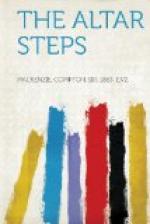The Rhos or, as it is popularly written and pronounced, the Rose is a tract of land in the south-west of the Duchy of Cornwall, ten miles long and six at its greatest breadth, which on account of its remoteness from the railway, its unusual geological formation, and its peninsular shape possesses both in the character of its inhabitants and in the peculiar aspects of the natural scene all the limitations and advantages of an island. The main road running south to Rose Head from Rosemarket cuts the peninsula into two unequal portions, the eastern and by far the larger of which consists of a flat tableland two or three hundred feet above the sea covered with a bushy heath, which flourishes in the magnesian soil and which when in bloom is of such a clear rosy pink, with nothing to break the level monochrome except scattered drifts of cotton grass, pools of silver water and a few stunted pines, that ignorant observers have often supposed that the colour gave its name to the whole peninsula. The ancient town of Rosemarket, which serves as the only channel of communication with the rest of Cornwall, lies in the extreme north-west of the peninsula between a wide creek of the Roseford river and the Rose Pool, an irregular heart-shaped water about four miles in circumference which on the west is only separated from the Atlantic by a bar of fine shingle fifty yards across.
The parish of Nancepean, of which Mark’s grandfather the Reverend Charles Elphinstone Trehawke had been vicar for nearly thirty years, ran southward from the Rose Pool between the main road and the sea for three miles. It was a country of green valleys unfolding to the ocean, and of small farms fertile enough when they were sheltered from the prevailing wind; but on the southern confines of the parish the soil became shallow and stony, the arable fields degenerated into a rough open pasturage full of gorse and foxgloves and gradually widening patches of heather, until finally the level monochrome of the Rhos absorbed the last vestiges of cultivation, and the parish came to an end.
The actual village of Nancepean, set in a hollow about a quarter of a mile from the sea, consisted of a smithy, a grocer’s shop, a parish hall and some two dozen white cottages with steep thatched roofs lying in their own gardens on either side of the unfrequented road that branched from the main road to follow the line of the coast. Where this road made the turn south a track strewn with grey shingle ran down between the cliffs, at this point not much more than grassy hummocks, to Nancepean beach which extended northward in a wide curve until it disappeared two miles away in the wooded heights above the Rose Pool. The metalled coast road continued past the Hanover Inn, an isolated house standing at the head of a small cove, to make the long ascent of Pendhu Cliff three hundred and fifty feet high, from the brow of which it descended between banks of fern past St. Tugdual’s Church to the sands of Church Cove, whence it emerged




